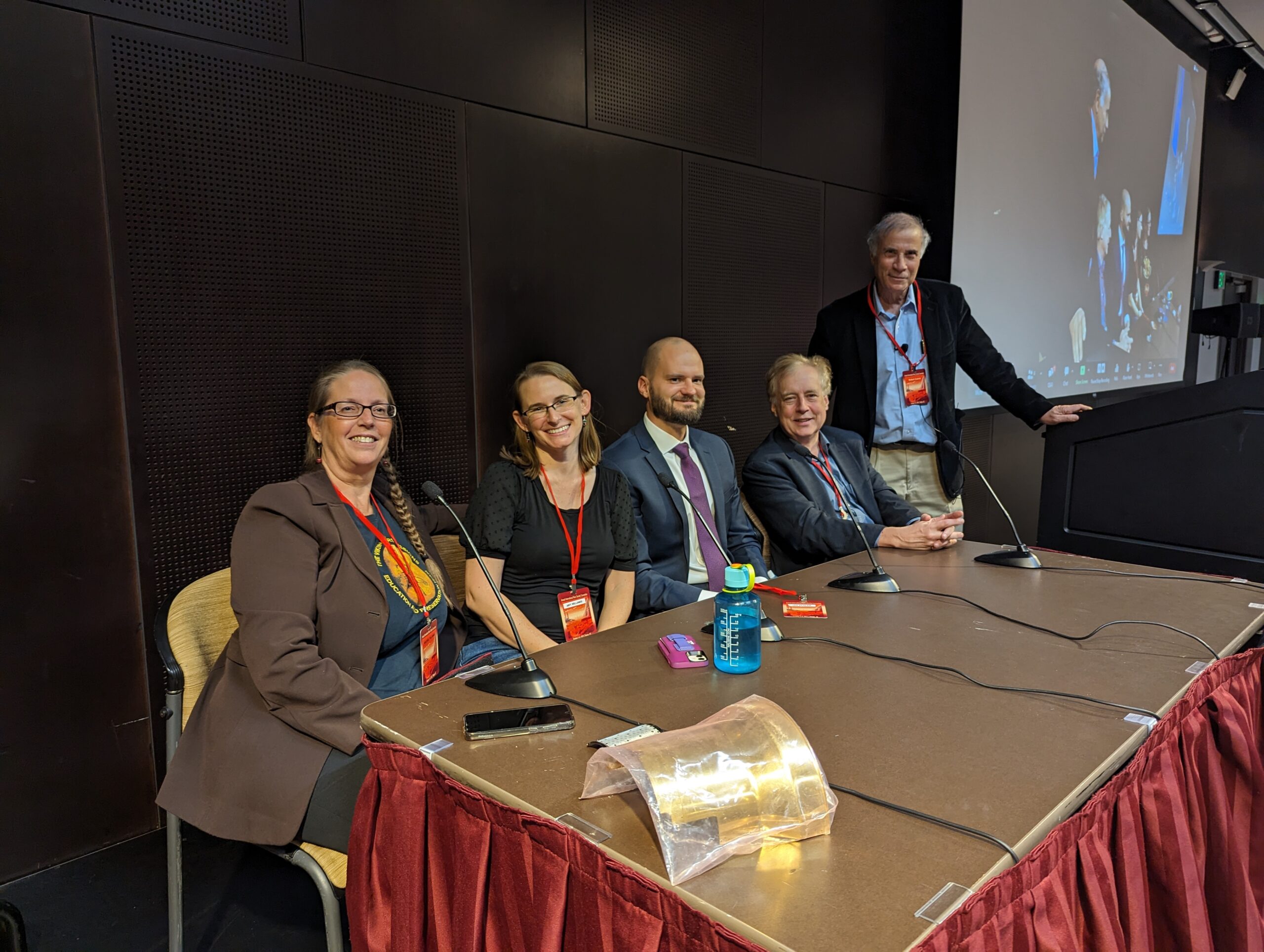Last week at the Mars Society Convention I had an opportunity to talk to fellow astrobiologists, leaders of NASA Mars Exploration Program, and concerned public. Here are my thoughts.
Cite as: Spacek, J. (2023) “A way forward for NASA astrobiology”. Primordial Scoop, e20231012. https://doi.org/10.52400/UQHF7824
The Mars-interested public is dismayed about the Mars astrobiology program – as it should be.
Although much of NASA funded research concludes that extant life likely is on Mars today,1 instruments sent to Mars since Viking would miss life in the Atacama Desert,2 in Earth’s Antarctic glaciers, and potentially on your kitchen floor, if you swept it recently.
NASA is proposing to return samples from one of Mars’ less hospitable sites. No astrobiologist would be surprised if Jezero’s ancient, parched, and irradiated rocks held no extant life, while other sites did. Unless life on Mars is much more abundant than astrobiologists expect, the sample return mission is irrelevant for search for extant life and should not be counted as such.
The 2023-2032 Decadal Survey3 entitled “Origins, Worlds, and Life” says that search for extant life is NASA’s priority, yet the Panel on Mars came up with only one life finding mission: Mars Life Explorer (MLE). The MLE is a downgraded version of the Red Dragon mission5 which was proposed in 2017 by Carol Stoker, Chris McKay and other astrobiologists to conclusively find life (as we know it) on Mars.
The downgrade is consequential. Although MLE proposes to “search for extant life before we send humans there,” this mission would likely not be able to conclusively do so. All of the proposed biosignatures – organics, non-equilibrium gases, depletion of isotopic ratios – are inconclusive and can be generated via abiotic processes. Further, the instruments listed in the proposal were shown to not be sensitive enough to find life in Atacama Desert.2
Why was the mission downgraded in the Decadal Survey? Perhaps because NASA does not allow missions to rely on collaborations with foreign research groups.
However, I also believe that the Decadal Survey followed the problematic “consensus approach” dictated by NASA’s Network for Life Detection (NfoLD).
The consensus6,7 generated by NfoLD held that life is unlikely to be found conclusively. This claim runs counter to much thinking in astrobiology, including those who proposed Red Dragon. Field astrobiologists who study rare and sparse life in Mars analog sites on Earth can find life conclusively. They all recognize the chance that they might miss some exotic alien life forms. However, they can conclusively and sensitively search for extant life that uses DNA, RNA, or other genetic polyelectrolytes.8 Further, if Mars and Earth exchanged material in a way that enabled intra Solar System panspermia, Martians use DNA.9-11
The MLE is proposed to fly in 2039, “if NASA increases funding to Mars astrobiology program.” This delay may be seen as necessary to allow missions to other targets to continue until the sunk and planned costs for MSR are cleared.
However, the cost of the MLE mission is four times higher than the cost of the Red Dragon5 mission. One of the reasons for the higher price is a requirement for high degree sterilization.
The planned timeline likely makes MLE mission to search for extant life on Mars irrelevant and illogical. NASA Administrator Bill Nelson declared that NASA will send humans to Mars before 2040.12-14 Taken at face value, this means that NASA will waste money to sterilize the MLE lander to inconclusively search for life on Mars in the same year that NASA sends humans to Mars. But humans on Mars negate the planetary protection rules that make MLE expensive. This lacks internal logic even if we set aside the possibility that by 2039, the Chinese National Space Administration (CNSA)15-17 or private organizations18-21 might already have humans on Mars.
The NfoLD’s “consensus” White Paper was criticized by the National Academy of Sciences and by many individuals who posted on our blog (www.primordialscoop.org).22-25 Central to their criticism was the view, with which I concur, that science advances via a competition of ideas, not by consensus.
The “consensus approach” has already stifled competing inconvenient ideas. Previously, I proposed to include in the “Future High Priority Research Avenues” section of the NfoLD’s white paper26 draft that: “The search for life on Mars must be the number one priority of NASA’s astrobiology program. While all other astrobiology targets will remain unaffected by human activities in decades and centuries to come, Mars is the only exception.” This idea was removed from the final version of the white paper, along with my name and every other contribution I proposed that questioned the consensus.
My guess is that NfoLD is interested mainly in exoplanets. Acknowledging the urgency of search for life on Mars would distract from their field. But pretending that the problem does not exist does not make it go away. The NfoLD’s forced consensus might stifle competition within NASA, but NASA is not the only player in the interplanetary science.27,28 I believe that NASA should embrace the new reality we live in.
Thus, unless NASA is prepared to block private missions or missions from other sovereign nations to Mars, NASA must change its policy or be prepared to face criticism from citizens and politicians alike. As first principles:
(1) NASA’s astrobiology program must be scientific, promoting a competition of ideas, as recommended by US National Academy of Sciences Report22.
(2) Missions to study the potential life on Mars must occur before 2030, if only to reassure the world that Earth’s biosphere will not be affected by Martians coming back with private astronauts.
(3) To keep inspiring the nation, NASA must not lose the race to find life on Mars.
If it is too late to overhaul NASA’s heading and redirect budgets, let me propose a low-cost alternative.
I would suggest that NASA announces a competition to find and study life on Mars.
Submissions will be accepted in a form of a working instrument duplicate of the instrument flown to Mars. This will demonstrate abilities in NASA controlled Martian simulant conditions. Prizes would to be awarded for the first two teams to independently confirm each other findings on Mars – either “positive” or “negative with a high degree of certainty for a specified target.”
This award structure recognizes that although negative results do not prove that Mars lacks a biosphere, they are still valuable. The prize for a “negative” result can be awarded to teams that demonstrate, within settings selected by NASA judges, that their instruments can find at least one cell per cubic centimeter in a bucket of Mars soil simulant or within a bucket of dusty ice. Cells can be any type of Terran life. To exclude flukes multiple buckets with various “life” concentrations and multiple sterile controls should be used.
Remember, to find life on Mars, we do not need to land cumbersome rovers. For example, a mission based on small version of partially aerobreaked “Rods from God” kinetic penetrators to unambiguously search for life in Martian ice might cost as little as $30 million when delivered by a small private rocket.
If NASA starts a race, many teams will join. Universities with sponsors will be able to afford to send a life finding missions and life on Mars will be found thanks to NASA.
If NASA does not start the race, private missions will likely fly anyway – without NASA.
References
1 Carrier, B. L. et al. Mars Extant Life: What’s Next? Conference Report. Astrobiology 20, 785-814 (2020). https://doi.org:10.1089/ast.2020.2237
2 Azua-Bustos, A. et al. Dark microbiome and extremely low organics in Atacama fossil delta unveil Mars life detection limits. Nature Communications 14, 808 (2023).
3 National Academies of Sciences, E. & Medicine. Origins, worlds, and life: a decadal strategy for planetary science and astrobiology 2023-2032. (2022).
4 The Planetary Society, Amy Williams interviewed by Sarah Al-Ahmed at Planetary Radio, Aug 09, 2023, minute 41 “To feel confident [that we have found life], you might have to send another mission to further investigate, maybe you send humans.”, <https://www.planetary.org/planetary-radio/2023-mars-life-explorer> (
5 Heldmann, J. L. et al. Red Dragon drill missions to Mars. Acta Astronautica 141, 79-88 (2017). https://doi.org:10.1016/j.actaastro.2017.10.002
6 Meadows, V. et al. Community Report from the Biosignatures Standards of Evidence Workshop. arXiv preprint arXiv:2210.14293 (2022), p. 5: “However, the detection of extraterrestrial life, in our Solar System and beyond, is sufficiently challenging that it is likely that multiple measurements and approaches, spanning disciplines and missions, will be needed to make a convincing claim. Life detection will therefore not be an instantaneous process, and it is unlikely to be unambiguous—yet it is a high-stakes scientific achievement that will garner an enormous amount of public interest.”.
7 Green, J., Hoehler, T., Neveu, M., Domagal-Goldman, S., Scalice, D. & Voytek, M. Call for a framework for reporting evidence for life beyond Earth. Nature 598, 575-579 (2021).
8 Špaček, J. & Benner, S. A. Agnostic Life Finder (ALF) for Large-Scale Screening of Martian Life During In Situ Refueling. Astrobiology 22, 1255-1263 (2022).
9 Fiedler, M. S. & de Souza Mendonça Jr, M. Post-dispersal astrobiological events: modelling macroevolutionary dynamics for lithopanspermia. Extremophiles 27, 3 (2023).
10 Worth, R. J., Sigurdsson, S. & House, C. H. Seeding life on the moons of the outer planets via lithopanspermia. Astrobiology 13, 1155-1165 (2013).
11 Stöffler, D. et al. Experimental evidence for the potential impact ejection of viable microorganisms from Mars and Mars-like planets. Icarus 186, 585-588 (2007).
12 NASA. How Investing in the Moon Prepares NASA for First Human Mission to Mars, <https://www.nasa.gov/sites/default/files/atoms/files/moon-investments-prepare-us-for-mars.pdf> (2020).
13 NASA. Moon to Mars Overview, <https://www.nasa.gov/topics/moon-to-mars/overview> (2023).
14 NASA. 2022 ‘State of NASA’ Address from Administrator Bill Nelson, t=21:17, <https://www.youtube.com/watch?v=7jTaQQA5vAk&t=1276s> (2022).
15 Tian, H., Zhang, T., Jia, Y., Peng, S. & Yan, C. Zhurong: Features and mission of China’s first Mars rover. Innovation (Camb) 2, 100121 (2021). https://doi.org:10.1016/j.xinn.2021.100121
16 Wang, X. & Wang, X. Research Progress and Preliminary Scheme of Space Transportation System for Human Mars Exploration. Aerospace China 22, 3-14 (2021).
17 Woo, R. & Gao, L. China plans its first crewed mission to Mars in 2033, <https://www.reuters.com/business/aerospace-defense/china-plans-its-first-crewed-mission-mars-2033-2021-06-24/> (2021).
18 Musk, E. Making Life Multi-Planetary. New Space 6, 2-11 (2018). https://doi.org:10.1089/space.2018.29013.emu
19 Torchinsky, R. Elon Musk hints at a crewed mission to Mars in 2029, <https://www.npr.org/2022/03/17/1087167893/elon-musk-mars-2029> (2022).
20 Heldmann, J. L. et al. Mission Architecture Using the SpaceX Starship Vehicle to Enable a Sustained Human Presence on Mars. https://home.liebertpub.com/space (2021). https://doi.org:10.1089/SPACE.2020.0058
21 SpaceX. Mars and Beyond, The Road To Making Humanity Multiplanetary, <https://www.spacex.com/human-spaceflight/mars/> (2023).
22 National Academies of Sciences, Engineering, and Medicine. Independent Review of the Community Report from the Biosignature Standards of Evidence Workshop: Report Series—Committee on Astrobiology and Planetary Sciences. (2022) p.2 Finding 5: The scientific process of multiple working hypotheses is the most rigorous and timeproven means by which to assess evidence and claims related to life detection. The establishment of a new external verification entity to oversee assessment and publication of life detection claims could have unintended negative consequences for open science and for fairness.
23 Harrison, M., and Benner, S. A. (2022) “Mark Harrison and Steven Benner remark on NASA’s “Standards” White Paper. Does NASA’s drive for consensus make young scientists susceptible to being trampled by mastodons?”. Primordial Scoop, e20220525. https://doi.org/10.52400/DVGO6088.
24 Cleland, C. (2021) “Why searching for extraterrestrial life with a universal biosignature detection framework is a mistake.” Primordial Scoop, 2021, e1122. https://doi.org/10.52400/OAFE7594.
25 Grinspoon, D. H. We can try to devise rules for how detecting alien life should unfold, but E.T. might not play along., <https://skyandtelescope.org/astronomy-blogs/grave-expectations/> (2022).
26 Meadows, V. et al. Community Report from the Biosignatures Standards of Evidence Workshop. arXiv preprint arXiv:2210.14293 (2022).
27 Baumgardner, D. et al. Deducing the Composition of Venus Cloud Particles with the Autofluorescence Nephelometer (AFN). Aerospace 9 (2022). https://doi.org:10.3390/aerospace9090492
28 French, R. et al. Rocket Lab Mission to Venus. Aerospace 9 (2022). https://doi.org:10.3390/aerospace9080445
Thanks to Steven Benner and Courtney Pasternak for editing the text.



